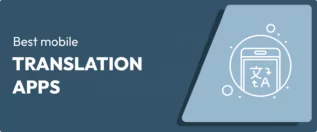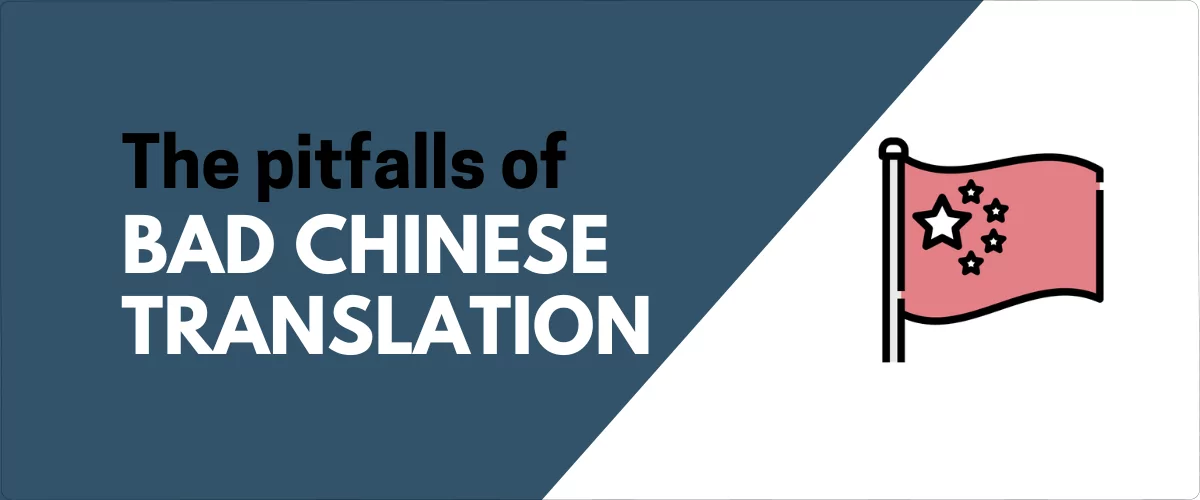
In this post
Bad translations from and to Chinese are popular staples of online lists about translation fails. You can find countless of them on the Internet, most often containing images of public signs and menus from China.
And, admittedly, some of them are pretty funny.
However, instead of merely stopping at “Haha, this is amusing” and moving on, we thought it would be interesting to dive deeper into where these bad Chinese translations come from.
Because when you look more closely at the underlying reasons, while the results are still funny, you understand that they are usually the outcome of a chain of unfortunate events that started off perfectly innocent.
So, what follows is not only a list reasons why translation fails happen so often with the Chinese language but also a deep dive into a number of examples and how each case came about.
Why Are There So Many Bad Chinese Translations?
There is a range of factors that contribute to the prevalence of less-than-correct translations of Chinese. Here they are.
Chinese is a Difficult Language
First of all, Chinese is simply one of the hardest languages to convert from one language to another. It’s very different from Western languages in terms of its structure and how it works.
For example, Chinese does not have an alphabet. Instead, it uses between 50,000 and 80,000 characters, each with its distinct meaning.
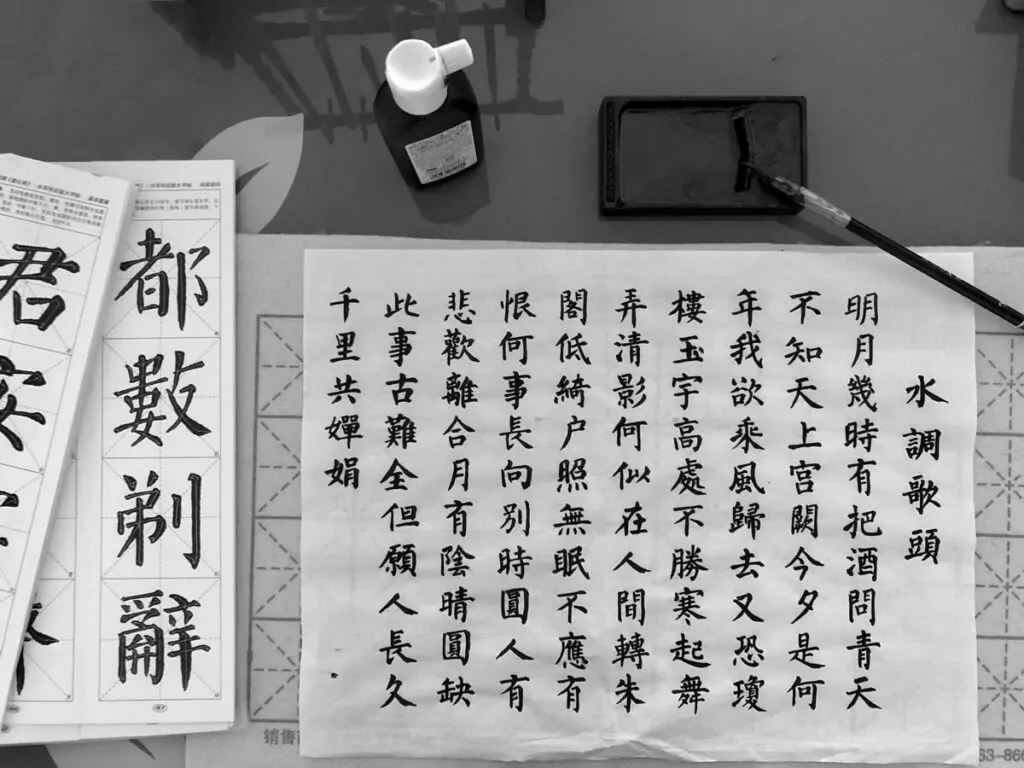
Just to be considered literate, you need to know 2,500-3,000 of them. Quite a bit more than the 26 letters of the English alphabet, don’t you think? And that’s just to translate basic Chinese.
Plus, the grammar is very different, too. If you were to convert a Chinese sentence into another language word for word, the result wouldn’t make sense. You need to do quite a big of rearranging so that it has the correct meaning in, say, English.
This is different, for example, when translating many European languages, where the word order is quite similar. It also makes it easier to produce bad translations with Chinese than other languages, at least when pairing it with English.
Characters Can Be Ambiguous
In addition to above, there are also some features of especially the written Chinese language that make it difficult to translate.
First of all, Chinese characters often have more than one meaning. While they are most often generally related, there are still differences. Among other things, the character 报 (“bào”) can take on the following meanings:
- “Newspaper”
- “Journalistic”
- “Report” and “to report”
- “To respond”
- “To retaliate”
- “Telegram”
It’s easy to see how you can get the meaning of an entire sentence wrong if you incorrectly interpret just one character. In addition, because of the sheer number of Chinese characters, you also have many with very similar meanings that are used in different contexts.
What’s more, characters take on a new sense when combined with each other that can be very different from the original. For example, the characters 發 (“fā”) and 福 (“fú”) mean as much as “to get rich” and “good fortune” on their own. However, when you combine them to 發福, it means “fat” or “to gain weight” in Chinese.
This is exacerbated by the fact that during the transition from traditional to simplified Chinese, some words that had their own characters before were summarized under one. In many cases the words combined were homonyms, meaning they sound the same. We will discuss an example for that below.
Translating Chinese Requires a Lot of Interpretation
If the above wasn’t enough, there are other factors that add ambiguity to Chinese:
- It can be a relatively flowery language that likes to use a lot of adverbs and adjectives to make the language more figurative and metaphorical.
- Chinese doesn’t have inflections, meaning it does not form tenses or cases by changing words. Instead, a lot of these things need to be inferred from context.
- The language is also rich in idioms, which are always very culturally rooted and should not be taken literally. In Chinese, entire concepts can often be expressed with just one word that needs an entire paragraph to explain in another language.
As a consequence, correctly translating Chinese requires a lot of interpretation, which is especially difficult for machine translation.
Strong Reliance on Automatic Translation
Speaking of which, when you see lists of Chinese translation fails, they are most often of things like menus and signs. Here, you have to understand who the people are who create these.
Most often the person who produces a “bad” Chinese translation is someone who doesn’t know the target language very well and relies on an online translation service to do the heavy listing. Think a local Chinese shop or restaurant owner or a low-level public servant. At the same time, they don’t have the means to proofread and check what the machine produces.
6 Chinese Translation Fails Explained
Ok, now that we have a better grasp on why Chinese often goes mistranslated, let’s go over some concrete examples to really drive the point home.
Screw Everything
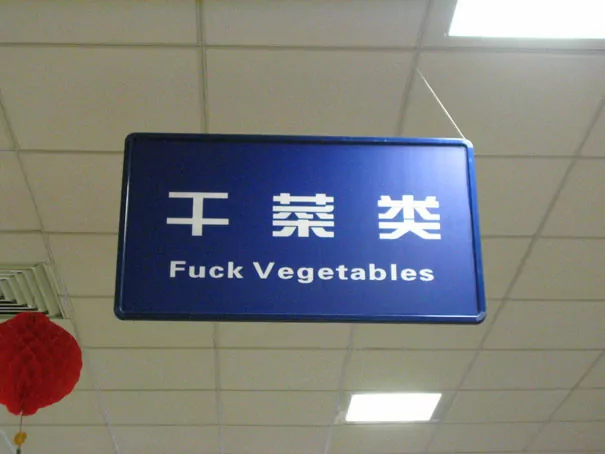
Images like the above that use the f-word in surprising circumstance are commonplace on lists of bad Chinese translations. And, what can we say, it is funny when you don’t know anything about the background. My dorm in Beijing had a restaurant which famously served “f*ck the bean curd” and there are plenty more examples where that came from.
So, how in the heck does this kind of thing happen?
The explanation is relatively simple. If you pay attention to these examples, you’ll notice that they usually have one thing in common, which is the character “干”. It’s one of the aforementioned characters that became an umbrella for several traditional Chinese characters when they were simplified.
One of them is 乾 (“gān”), which is means “dry” or “to dry”. That’s what you see in image above. The sign simply says “dried vegetables section” in a supermarket.
However, there is a second meaning to 干. It can also stand for 幹, in which case you pronounce it “gàn” and it means “to do” or “to work”. Colloquially people also use it for “to have sex”. This isn’t dissimilar to English, just think of phrases such as “doing it”.
However, for some reason, this latter meaning seems to be one that machine translation services tend to spit out. That’s why you find so many bad Chinese translations which are seemingly advertising fornication with different foodstuffs.
Can’t Stop Talking About Germany

Another thing that’s surprising to see is how often you seem to find mentions of Germany in failed Chinese translations. Do Chinese people just really like my home country? What’s going on with that?
It turns out that, in Chinese, country names are often formed by taking an adjective or noun that Chinese people associate with that country and then adding the word 国 (“guó”) to it, which means “country”.
For example, the United States are called 美国, which translates to “beautiful country” or “country of beauty”. France in Chinese is 法国, which roughly translates to “country of laws”. Germany happens to be 德国, meaning “virtuous country” or “country of morals”.
In written Chinese, the 国 part is also sometimes omitted, in cases where it is clear from the context that the first character refers to a country. Yet, 德 also still simply means “virtue”, which is often something to aspire to in China. The sentence above actually means “To be able to eat is a blessing, not wasting food is a virtue”.
So, next time you see a Chinese translation that inexplicably seems to involve Germany, know that it likely was talking about something virtuous originally. The same mechanism is probably how this street got its name translated wrong due to the presence of the 美 character:
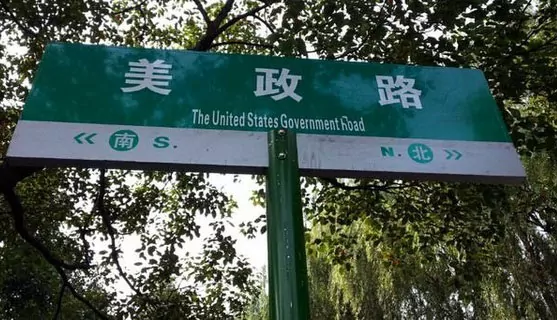
When There is More Than One Meaning
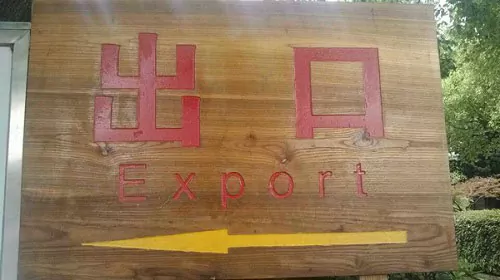
One of the most common problems with translation and even learning another language are words that have more than one meaning. It makes them easy to confuse. As mentioned earlier, just like other languages, Chinese has many of them.
That’s what is at play in the image above. The word 出口 can mean both “export” and “exit”. Obviously, whoever made that sign above was not familiar enough with English to pick the right option here. So, the translation technically isn’t wrong, it’s just not the correct one in this context.
You can see a similar example below.
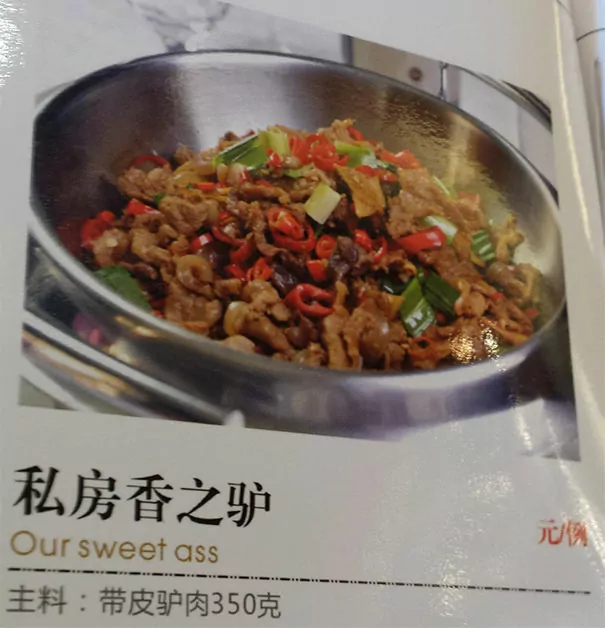
This is actually a dish that contains donkey meat. The character for donkey is “驴”. And what is another word for “donkey” in English? You got it, “ass.” The problem is, of course, that this word also has a different meaning in its target language.
The rest of the dish’s name likely means as much as “fragrant donkey meat after our own recipe”. But, of course, the translation software spit out something misunderstandable in this case.
The Word Order Is to Blame
We mentioned at the beginning that word order is different in Chinese than in other languages and that translating something word for word will therefore likely result in a wrong outcome. That’s exactly what happened in this next example of a bad Chinese translation.
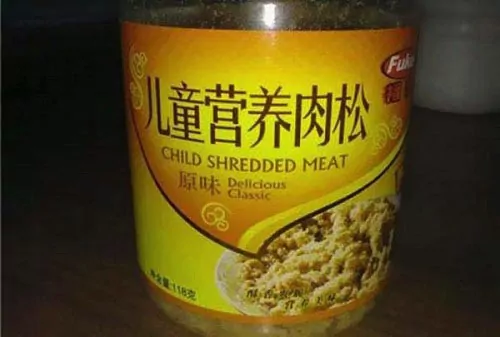
So, is this a jar full of shredded children’s meat? Of course not. The translation tool in question simply disregarded the word order.
This is, in fact, a product made for children, not of children. But apparently nobody was around who could check the translation.
Chinese Brand Names, Always Good for Confusion
In our article on transcreation, we have written extensively about the problems of adapting brand names for the Chinese market. Companies are challenged with finding characters to transliterate their names that both sound similar to the original as well as have related or at least positive meaning.
This, famously, has often resulted in hilarious outcomes. For example, when first entering the Chinese market, Mercedes Benz initially used 奔死 (pronounced “bēnsǐ”) as its name. It sounds similar to “Benz” but unfortunately, the characters chosen can mean as much as “to rush to die.” Not a great name for a car brand.
Coca-Cola, too, had a bad start with its Chinese name but ultimately settled on 可口可乐 (“kěkǒukělè”). The meaning behind the name is as much as “tasty fun”. But the individual characters still retain their meaning, which is why, when put into translation software, you can get “Small may be happy” as in the image below.
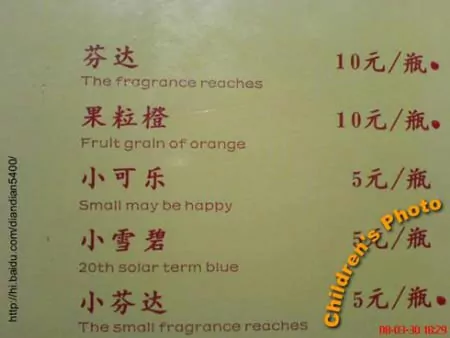
Originally, the menu simply says “small cola”. As you can see, bad Chinese translations go both ways.
Think Before You Ink
It’s important to remember that the problem goes both ways. In the Western world, you can also find plenty of examples of bad translations to Chinese, not just the ones from Chinese most often ridiculed online.
One very common examples here are tattoos. Getting Chinese characters written on your body was a bit of a trend for a while. Unfortunately, the results are often similar to flawed machine translations into English, much to the chagrin of people who speak (and read) Chinese.
A common problem here is that both tattooers and tattooees don’t know the correct orientation of characters involved. That’s how you get things like the image below where a character is upside down.
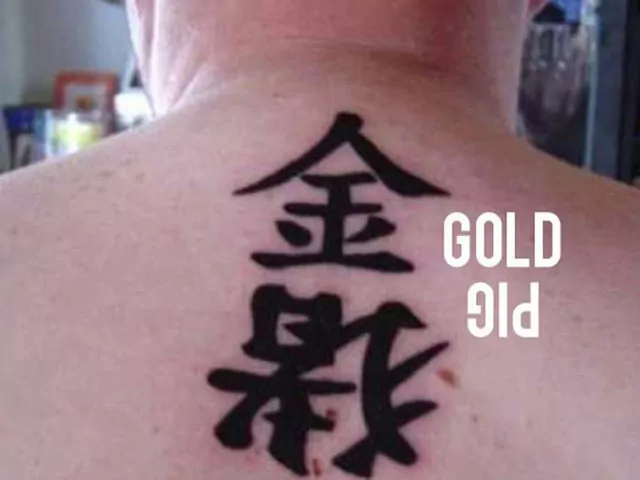
Mirrored characters are also not a rare occurrence. However, most often people get Chinese tattoos that either don’t make sense at all or that have a very different meaning than they intended.
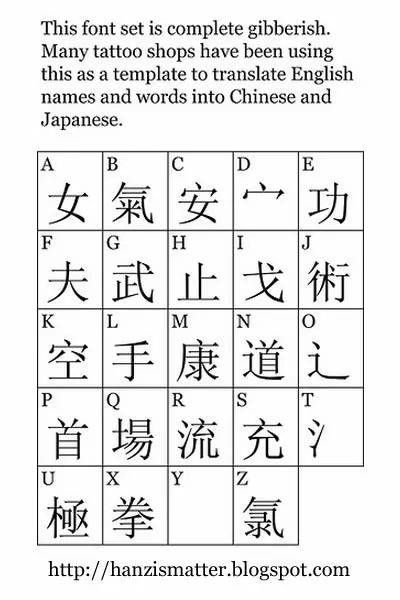
If you want more examples, there is an entire blog on this topic.
By the way, the guy below clearly wins the Chinese character tattoo competition.
Struggling With Translating Your Website to Chinese? Don’t Let Your Translation Plugin Be the Reason!
As you can see above, if your goal is to translate your website from or to Chinese, you definitely need to have someone at hand who knows what they are doing. Otherwise, you might end up with unintentionally hilarious outcomes.
Since this is challenging enough, the process of implementing your translations on your WordPress site should be as a easy as possible. This is where TranslatePress comes into play. Our translation plugin has all the features you need to make your site multilingual, even when dealing with a difficult language like Chinese. Here’s how it works.
1. Pick Your Target Language
With TranslatePress installed on your website, simply go to Settings → General. Here, first choose your default language at the top. In this case, that’s Chinese, since that’s what we want to translate from. You can decide between different versions depending on whether your site uses traditional or simplified characters.
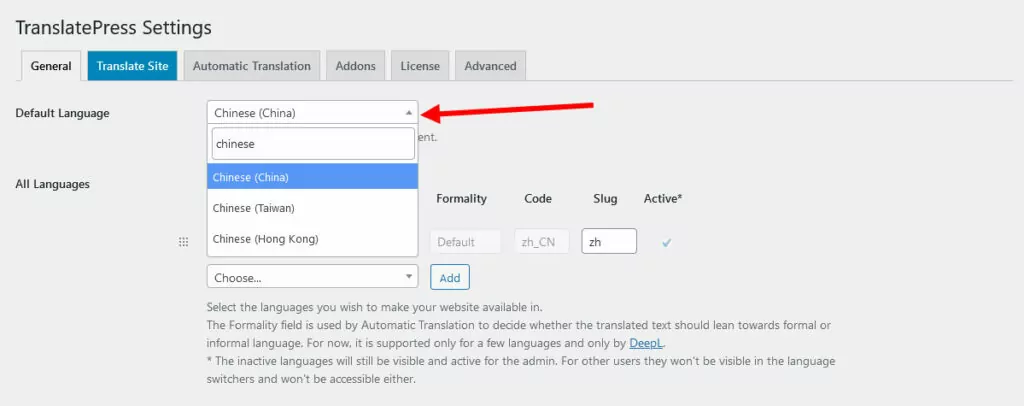
Then, under All Languages, use the drop-down menu to pick your target language. We are going with US English in this case. Click it and then hit Add.
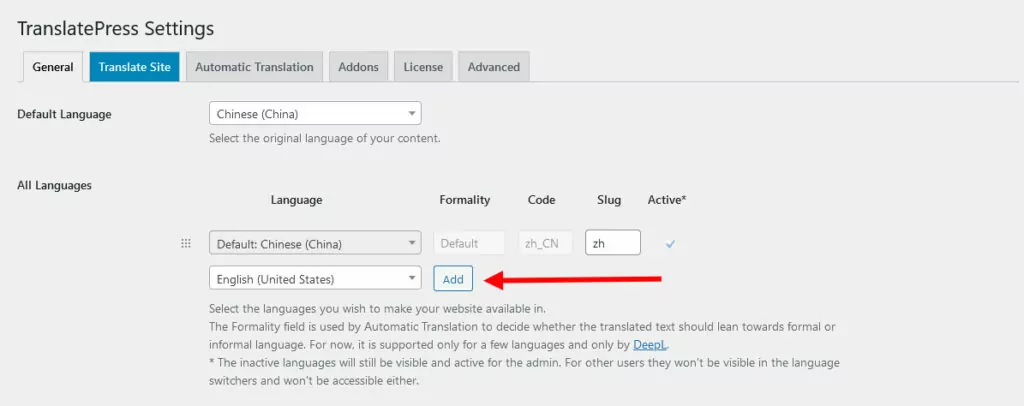
Make any other adjustments you need, such as customizing the slug, and save at the bottom. Naturally, you can use this process to add any other language pairs to your site as well, it doesn’t have to be those two.
2. Translate Your Content
After that, it’s time to translate your site. For that, click on Translate Site in the settings or WordPress admin bar.

This brings you to the main translation interface.
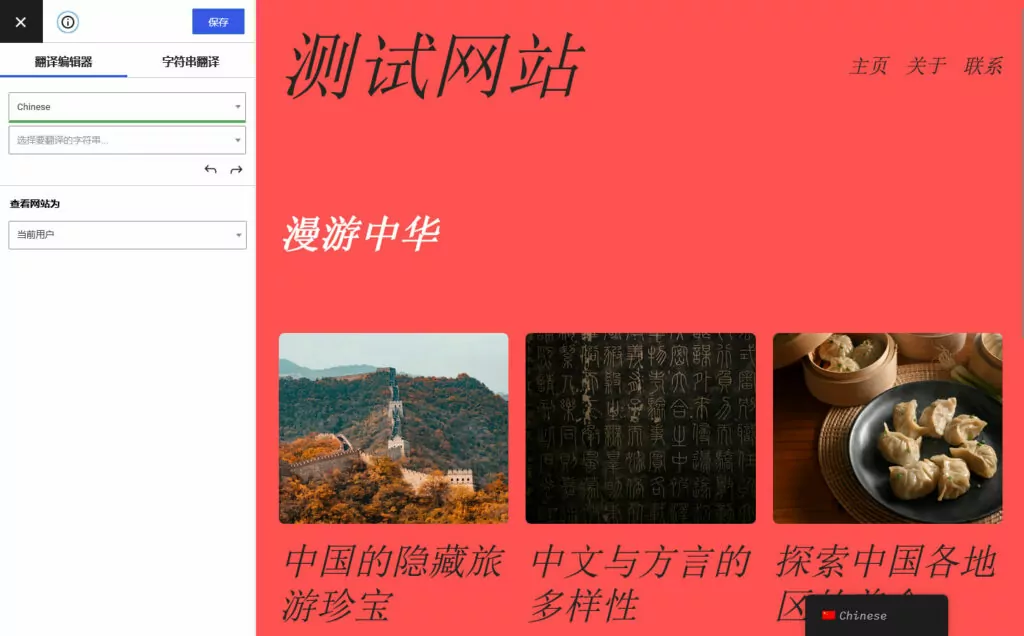
Here, use the drop-down menu at the top left to switch to your target language. This enables you to see any changes immediately.
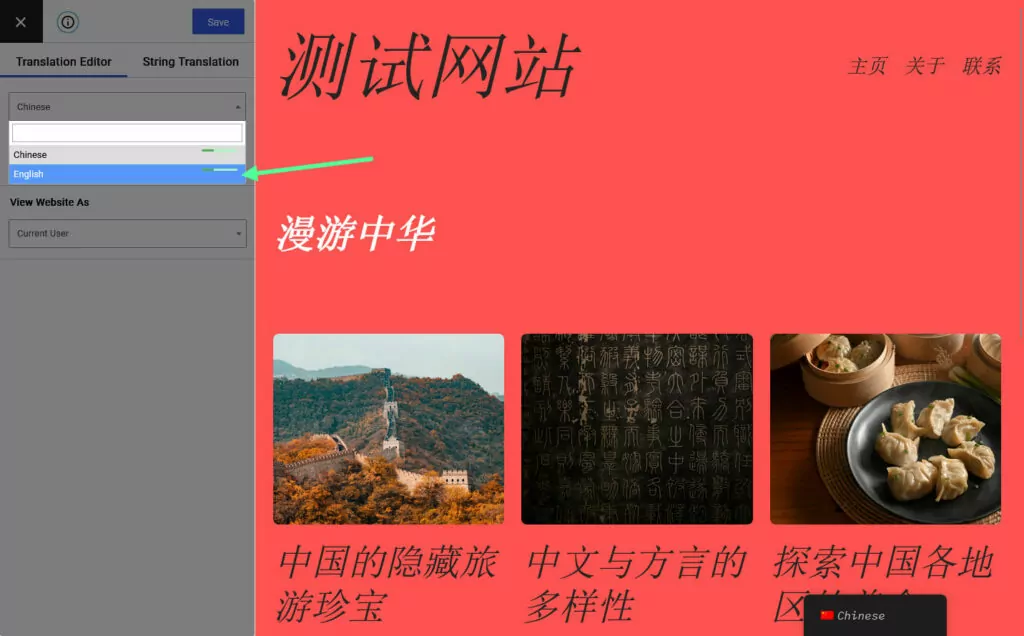
After that, pick the text you want to convert from Chinese. You can use the second drop-down menu, the back and forth arrows, or directly hover over any text in the preview window on the right and click the little pen symbol.
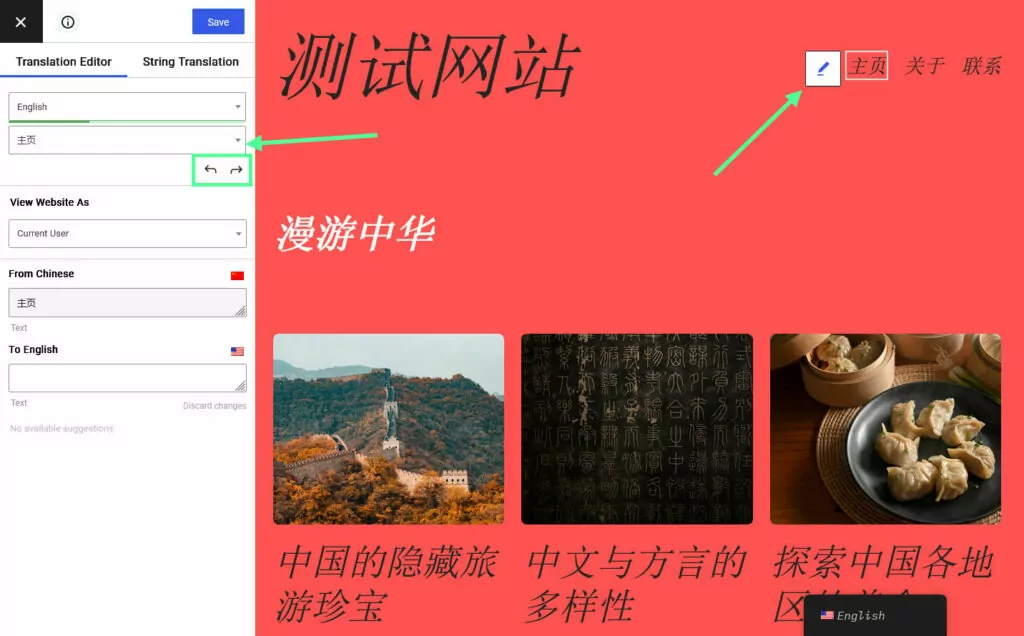
Doing so will open up a new field for the translated text. Input your target language, then click Save at the top.
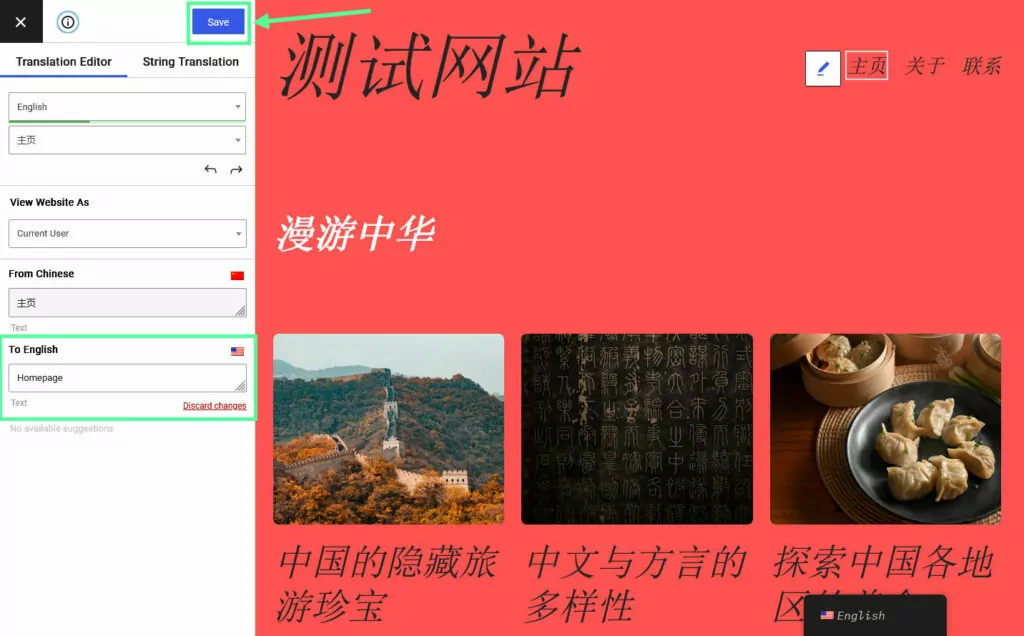
When you do, the translated version will automatically appear in the preview window.
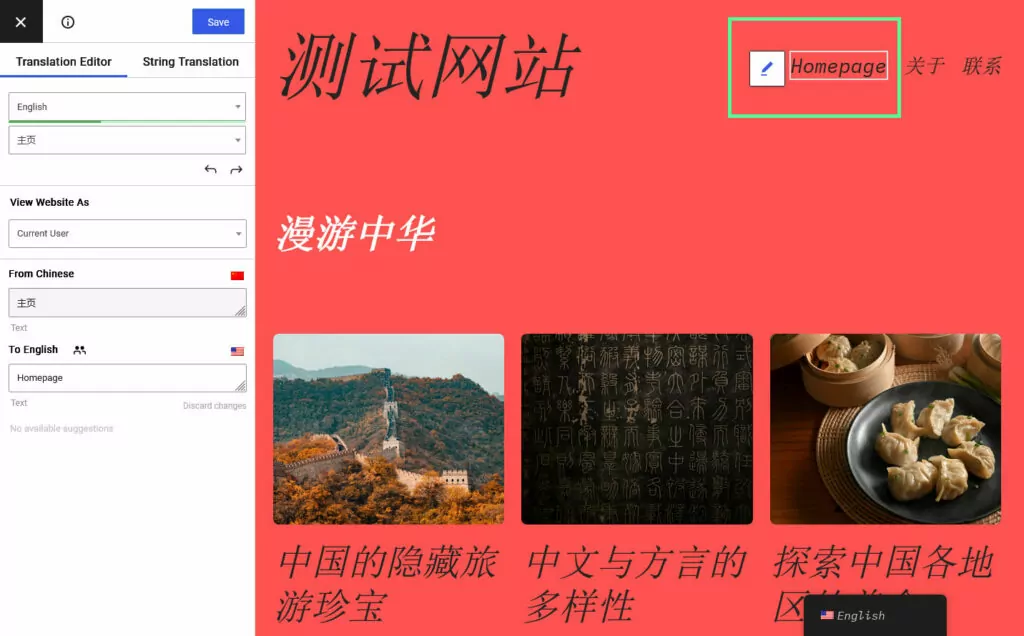
In addition, it will also be visible on the front end of your site whenever somebody uses the language switcher (you can also add one using Elementor).
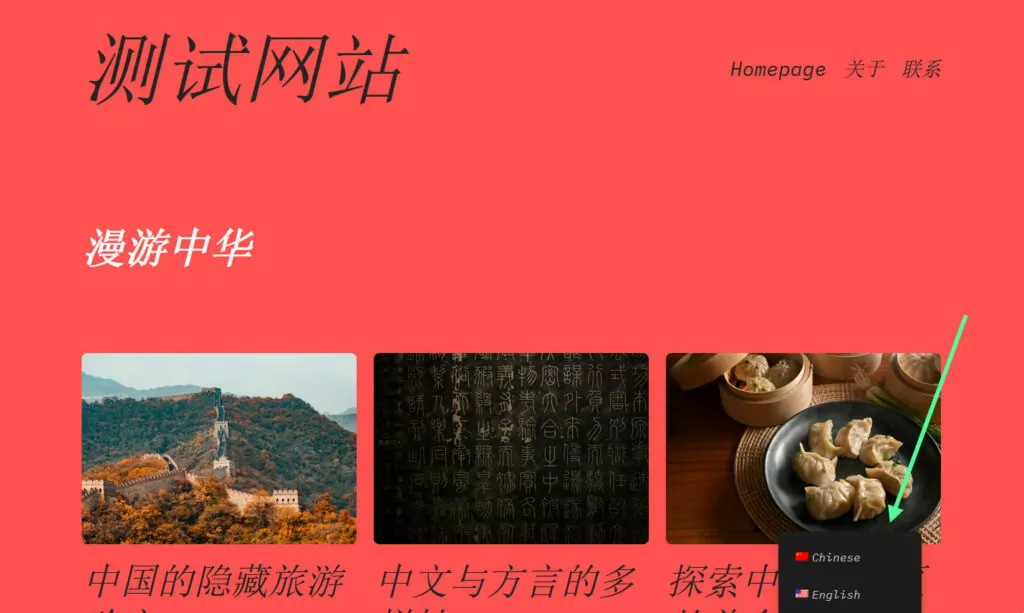
You can use the same process to translate images. Pick them from the translation interface, provide a link to a localized version, and save.
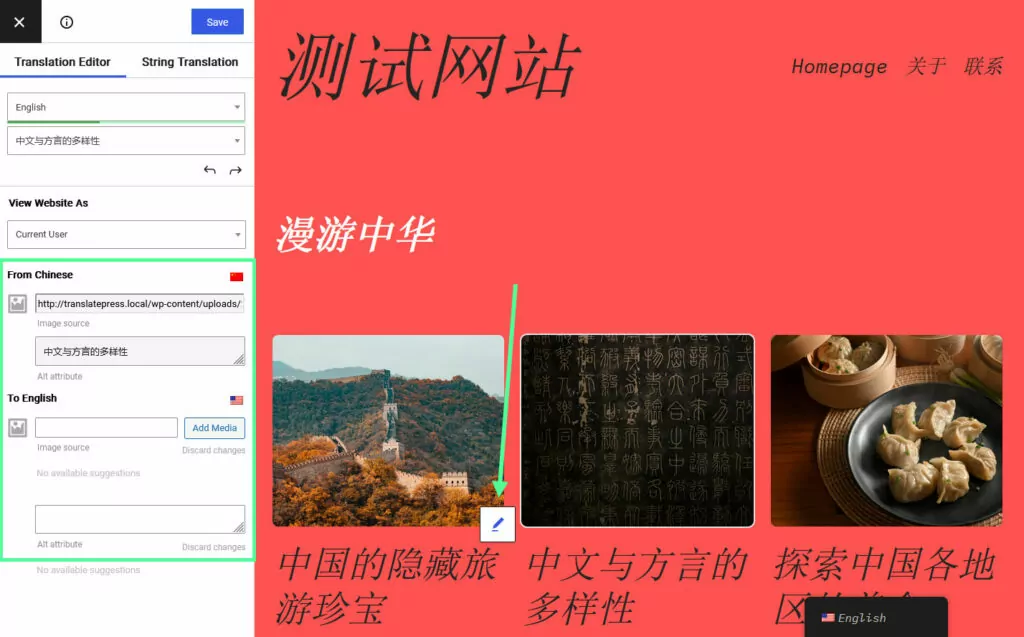
Other TranslatePress Features
Aside from the above, TranslatePress offers these features to translate your WordPress site more easily:
- Automatic translation — Use machine translation services like Google Translate and DeepL to convert your site more quickly. Note that only Google Translate is available in the free plugin version. Also, naturally, be weary about using just machine translation when converting your site from and to Chinese. We have seen enough examples of what may happen if you don’t double check.
- String translation — Convert strings from themes, plugins, WordPress itself, and more.
There is also a premium version of TranslatePress with additional features:
- Multilingual SEO pack — Translate your page URLs, SEO titles, meta descriptions, ALT tags, and other important SEO markers, including into Chinese. This helps you get found on Google.
- Translator accounts — When working with translation agencies and freelancers to convert your website to other languages, you can allow your service providers to do translations directly on your site.
- Browse as user role – Look at your site as a specific user role to understand if it has been properly translated for users with different permission levels.
- User language-specific navigation – Display different menus for different languages.
- Automatic user language detection – Automatically show your website in a user’s preferred language (via browser settings or location).
TranslatePress Pro comes in three pricing tiers so you can pick what makes the most sense for you.
TranslatePress Multilingual
Don’t Fear Bad Chinese Translations
Translating Chinese correctly is no easy feat. It is known as one of the hardest languages to learn and getting to a level where you can create translations from and to Chinese that sound natural takes a lot of time and effort. That’s why a lot of people rely on automatic translation services, which is how we end up with Chinese translation fails that people like to make fun of online.
Hopefully, you have seen above that many of these “bad” translation make sense if you dive more deeply into the reasons behind it. So, next time you see one that bewilders you, keep in mind that it most likely has a very innocent explanation. Plus, remember that bad translations go both ways, so be especially weary when you get a tattoo.
Finally, if you are planning to translate your website from or to Chinese (hopefully without mistakes), remember to give TranslatePress a try.


